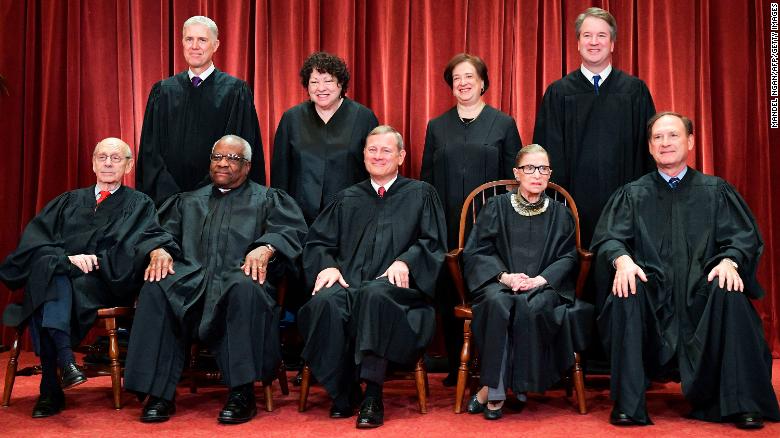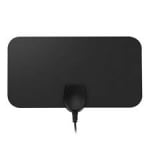
Justices of the US Supreme Court pose for their official photo at the Supreme Court in Washington, DC on November 30, 2018. – Standing from left: Associate Justice Neil Gorsuch, Associate Justice Sonia Sotomayor, Associate Justice Elena Kagan and Associate Justice Brett Kavanaugh.Seated from left to right, bottom row: Associate Justice Stephen Breyer, Associate Justice Clarence Thomas, Chief Justice John Roberts, Associate Justice Ruth Bader Ginsburg and Associate Justice Samuel Alito. (Photo by MANDEL NGAN / AFP) (Photo credit should read MANDEL NGAN/AFP/Getty Images)
Washington (CNN)Supreme Court justices Samuel Alito and Elena Kagan, appearing before House lawmakers Thursday, continued to voice the court’s entrenched opposition to televising oral arguments.
They said the possibility of cameras at hearings on cases — long advocated by many members of Congress and public interest groups — had not even been discussed among the nine justices in recent years.
Kagan, a 2010 appointee of President Barack Obama, said the topic had not been broached in their private sessions since she joined the bench.
She acknowledged benefits to the public seeing the nation’s highest court at work, but told a House Appropriations subcommittee that, “If seeing [the court] came at the expense of the way the institution functioned that would be a very bad bargain. And I do worry that cameras might come at that expense.”
Rep. Mike Quigley, D-Illinois, the panel’s chairman, had opened the hearing on the Supreme Court’s annual budget by urging more transparency and visibility of the court, including the possibility of audio recordings so more Americans could witness the activities that lead to decisions on the law of the land.
Pubic seating is at a premium in the court’s columned building across from the Capitol, and for the most consequential cases, would-be spectators often camp out for days for a seat. In recent years the court has put links to audio recordings on its website at the end of each week’s set of hearings.
Video recordings have never been permitted.
From Thursday’s comments, it did not appear that would change.
“We don’t want access at the expense of damaging the decision-making process,” Alito, a nominee of President George W. Bush, told the committee. He and Kagan said they worried that cameras would transform the tone of the hearings, perhaps participants would begin speaking in “soundbites” or justices’ questions would be misinterpreted.
Kagan said she often probed the lawyers from both sides in a “devil’s advocate” style and would not want her comments to be misconstrued on TV as revealing her personal position in a dispute.
Alito emphasized that the court had become more open through the decades and recalled an era in the 1990s when no transcripts or audio of oral arguments were available to the public. He noted that even when the court began making transcripts of oral arguments available on a daily basis in the early 2000s, the court initially declined to identify the individual justices who asked particular questions.
Gabe Roth of Fix the Court, a group that has pressed for cameras at the court, said later in a statement, “It’s a bit disingenuous for Justices Alito and Kagan to state calmly, in front of several video cameras and a dais full of attorneys, that cameras in their courtroom would somehow impact the tone of their hearings, especially since concerns over grandstanding haven’t proven true in other appeals courts that do allow video.”
#MeToo in the courts
In a separate line of questioning arising from the #MeToo movement, members of the House Appropriations subcommittee also asked Alito and Kagan about the Supreme Court’s exemption from the judiciary’s code of conduct, which covers US district court and appeals court judges.
“We take our ethical responsibilities very seriously,” Alito said, noting that while the justices are not bound by the code, they do adhere to its rules for ethical behavior.
Alito said the high court’s special place in the Constitution, above other US courts, precludes the justices from facing scrutiny from other judges, as lower court jurists are. Judges subject to misconduct complaints may be investigated and sanctioned by judicial committees.
Supreme Court justices can be removed from office only through the impeachment process, the same procedures that covers a president. In the history of the US judiciary, no Supreme court justice has ever been impeached by the House and convicted by the Senate.
Kagan said that Chief Justice John Roberts “is studying the question of whether to have a code of judicial conduction that is applicable only” to Supreme Court justices.
She offered no details, said it had not been discussed among all the other justices, yet added: “It’s something that is being thought very seriously about.”
[“source=cnn”]









